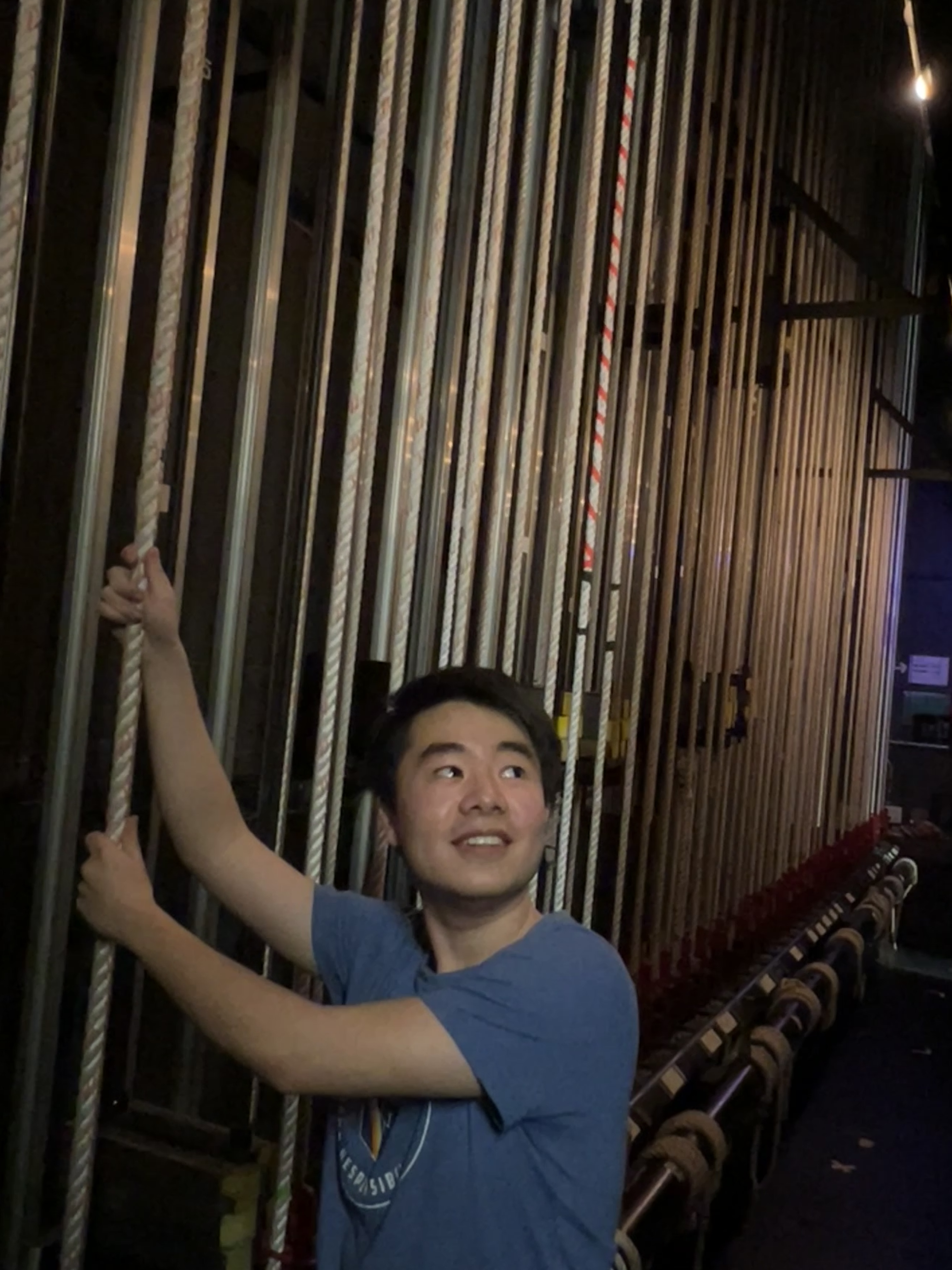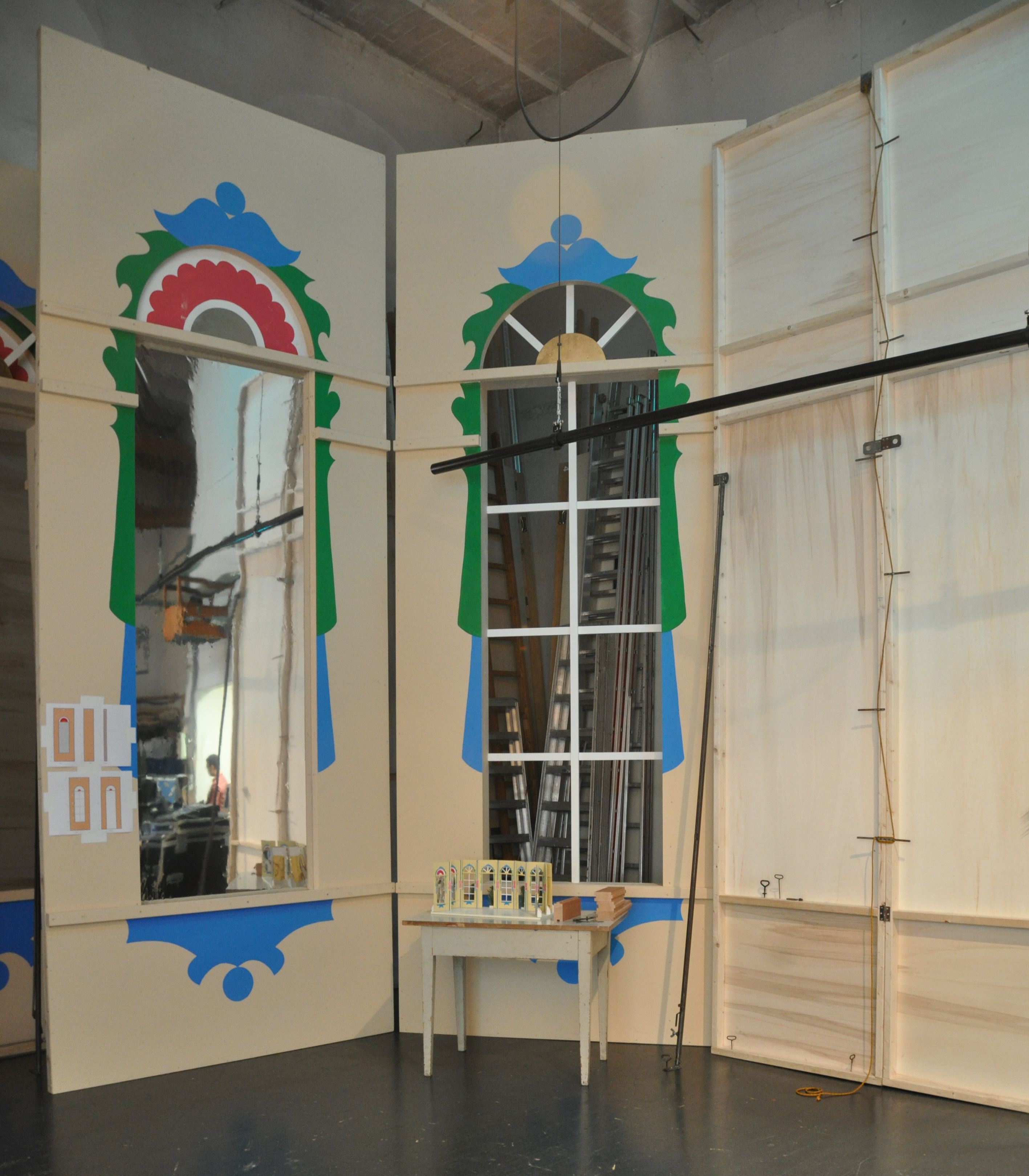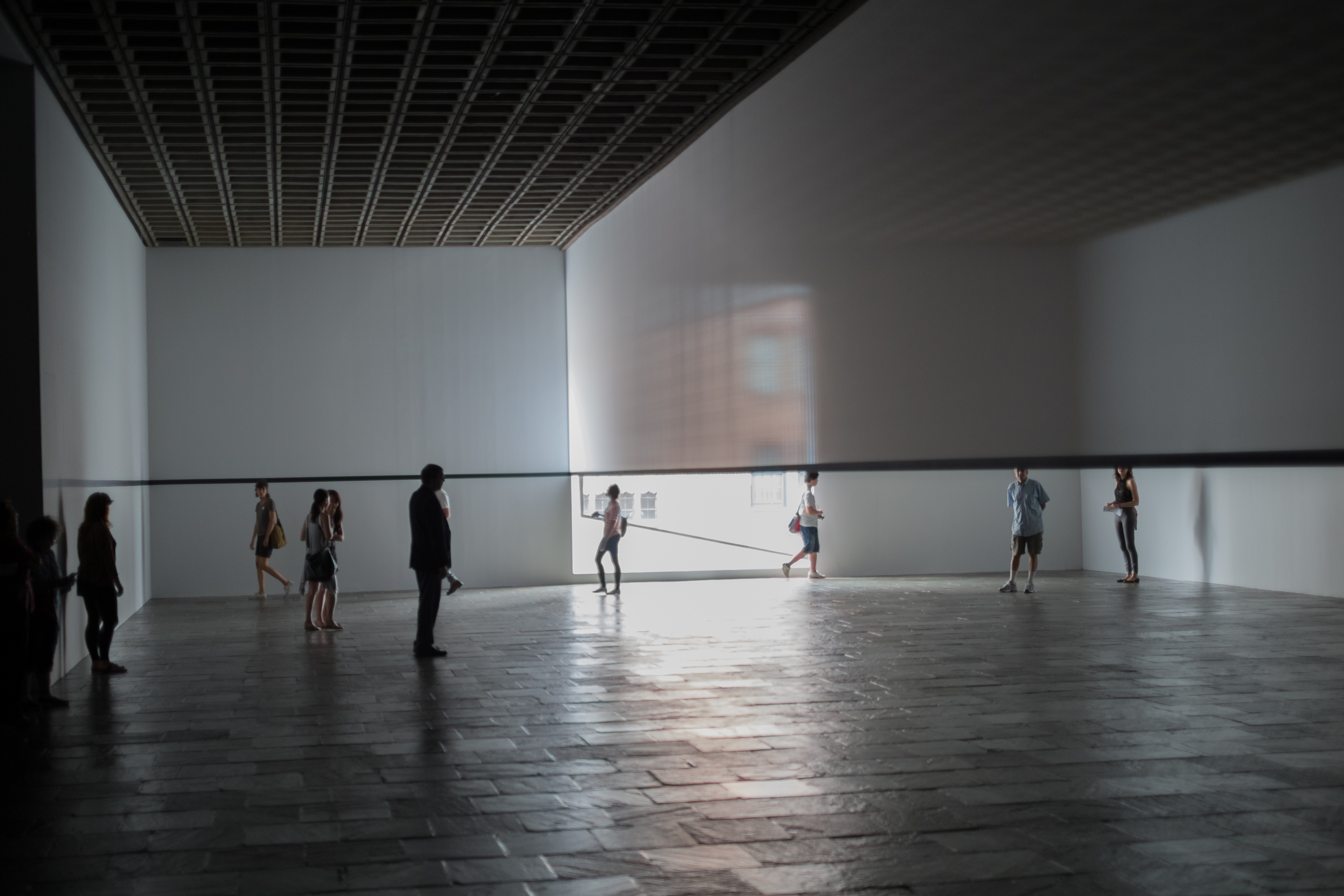|
Fly System
A fly system, or theatrical rigging system, is a system of ropes, pulleys, counterweights and related devices within a theater (structure), theater that enables a stage crew to fly (hoist) quickly, quietly and safely components such as curtains, lights, theatrical scenery, scenery, stage effects and, sometimes, people. Systems are typically designed to fly components between clear view of the audience and out of view, into the large space, the fly loft, above the stage (theatre), stage. Fly systems are often used in conjunction with other theatre systems, such as scenery wagons, stage lifts and stage turntables, to physically manipulate the mise en scène. Theatrical rigging is most prevalent in proscenium theatres with stage houses designed specifically to handle the significant dead and live loads associated with fly systems. building code, Building, Occupational Safety and Health Administration, occupational safety, and Fire safety#Fire code, fire codes limit the types and qu ... [...More Info...] [...Related Items...] OR: [Wikipedia] [Google] [Baidu] |
Fly Crew
A fly crew is a group of people who are in charge of maintaining and operating the fly system during theatre production. A member of a fly crew is also called a flyman. Despite the name, there is no gender restriction in order to work within a fly crew. Working as a member of the fly crew often requires being able to pay close attention and having physical strength and agility. During the performance, operators of the fly system will often be involved with changing the scenery or other stage effects on stage. Members of the fly crew may spend a lot of time waiting for predefined cues for operating the fly system: as a result, it is very important for the fly crew to pay close attention to signals given. During tech rehearsals, the fly crew is in charge of inspecting the fly system, maintaining the weight balance, and installing the scenery, lighting and other equipment needed for the show. To maintain the balance of the fly system, the fly crew needs to climb up to the loading galle ... [...More Info...] [...Related Items...] OR: [Wikipedia] [Google] [Baidu] |
Theater Bielefeld Schnürboden
Theatre or theater is a collaborative form of performing art that uses live performers, usually actors to present experiences of a real or imagined event before a live audience in a specific place, often a stage. The performers may communicate this experience to the audience through combinations of gesture, speech, song, music, and dance. It is the oldest form of drama, though live theatre has now been joined by modern recorded forms. Elements of art, such as painted scenery and stagecraft such as lighting are used to enhance the physicality, presence and immediacy of the experience. Places, normally buildings, where performances regularly take place are also called "theatres" (or "theaters"), as derived from the Ancient Greek θέατρον (théatron, "a place for viewing"), itself from θεάομαι (theáomai, "to see", "to watch", "to observe"). Modern Western theatre comes, in large measure, from the theatre of ancient Greece, from which it borrows technical terminolog ... [...More Info...] [...Related Items...] OR: [Wikipedia] [Google] [Baidu] |
Entertainment Services And Technology Association
The Entertainment Services & Technology Association (ESTA) is an American non-profit trade association that represents the entertainment technology industry and is dedicated to promoting professionalism and growth within it. It also provides a forum where interested parties can exchange ideas and information, create standards and recommend certain practices, and face problems in terms of training and certification. ESTA members provide a wide variety of products and services to the industry, which range from large corporations to individual designers. Its members include distributors, manufacturers, companies in the field of service and production, designers and consultants. ESTA is currently in charge of reviewing the DMX512 protocol (Digital MultipleX) as well as the development of the new sACN protocol (Streaming Architecture for Control Networks), both communications protocols used to control the lighting of scenarios and special effects. History In 2010 ESTA merged with ... [...More Info...] [...Related Items...] OR: [Wikipedia] [Google] [Baidu] |
McGraw Hill
McGraw Hill is an American education science company that provides educational content, software, and services for students and educators across various levels—from K-12 to higher education and professional settings. They produce textbooks, digital learning tools, and adaptive technology to enhance learning experiences and outcomes. It is one of the "big three" educational publishers along with Houghton Mifflin Harcourt and Pearson Education. McGraw Hill also publishes reference and trade publications for the medical, business, and engineering professions. Formerly a division of The McGraw Hill Companies (later renamed McGraw Hill Financial, now S&P Global), McGraw Hill Education was divested and acquired by Apollo Global Management in March 2013 for $2.4 billion in cash. McGraw Hill was sold in 2021 to Platinum Equity for $4.5 billion. History McGraw Hill was founded in 1888, when James H. McGraw, co-founder of McGraw Hill, purchased the ''American Journal of Railwa ... [...More Info...] [...Related Items...] OR: [Wikipedia] [Google] [Baidu] |
Electrical Conduit
An electrical conduit is a tube used to protect and route electrical wiring in a building or structure. Electrical conduit may be made of metal, plastic, fiber, or fired clay. Most conduit is rigid, but flexible conduit is used for some purposes. Conduit is generally installed by electricians at the site of installation of electrical equipment. Its use, form, and installation details are often specified by wiring regulations, such as the US National Electrical Code (NEC) and other building codes. Comparison with other wiring methods Electrical conduit provides very good protection to enclosed conductors from impact, moisture, and chemical vapors. Varying numbers, sizes, and types of conductors can be pulled into a conduit, which simplifies design and construction compared to multiple runs of cables or the expense of customized composite cable. Wiring systems in buildings may be subject to frequent alterations. Frequent wiring changes are made simpler and safer through the ... [...More Info...] [...Related Items...] OR: [Wikipedia] [Google] [Baidu] |
Multicable
In stage lighting, Stage Lighting Design Principle and Process a multicable (otherwise known as multi-core cable or mult) is a type of heavy-duty electrical cable used in theaters to power lights. The basic construction involves a bundle of individual conductors surrounded by a single outer jacket. Whereas single cables only have three conductors, multicable has ten or more. They are configured to run in six or eight-circuit varieties. Typically, both ends of multicable have a specific connector known as a Socapex, Socapex Connector. Technicians then combine the cables with break-outs and break-ins, which essentially are an octopus-like adapter with one Socapex end and six to eight [...More Info...] [...Related Items...] OR: [Wikipedia] [Google] [Baidu] |
Electric Flown In
Electricity is the set of physical phenomena associated with the presence and motion of matter possessing an electric charge. Electricity is related to magnetism, both being part of the phenomenon of electromagnetism, as described by Maxwell's equations. Common phenomena are related to electricity, including lightning, static electricity, electric heating, electric discharges and many others. The presence of either a positive or negative electric charge produces an electric field. The motion of electric charges is an electric current and produces a magnetic field. In most applications, Coulomb's law determines the force acting on an electric charge. Electric potential is the work done to move an electric charge from one point to another within an electric field, typically measured in volts. Electricity plays a central role in many modern technologies, serving in electric power where electric current is used to energise equipment, and in electronics dealing with electric ... [...More Info...] [...Related Items...] OR: [Wikipedia] [Google] [Baidu] |
Box Set (theatre)
In theatre, a box set is a set with a proscenium arch stage and three walls. The proscenium opening is the fourth wall. Box sets create the illusion of an interior room on the stage, and are contrasted with earlier forms of sets which contained sliding flaps and gaps between set pieces. Box sets are traditionally attributed to Elizabeth Vestris with the Victorian farce ''London Assurance'' by Dion Boucicault. But evidence suggests the first description of the box set was by Paolo Landriani in 1818, with his description of a ''scena parapettata''. They were popularized by Marie Wilton at the Prince of Wales's Royal Theatre. They later became a feature of realist theatre, and an example of the "fourth wall removed" principle that characterized the work of noted realists such as Henrik Ibsen's ''A Doll's House'', George Bernard Shaw's '' Pygmalion'', and Anton Chekhov's ''The Seagull''. Nineteenth-century theatrical scenery In the play style of realism, the box set of the st ... [...More Info...] [...Related Items...] OR: [Wikipedia] [Google] [Baidu] |
Muslin
Muslin () is a cotton fabric of plain weave. It is made in a wide range of weights from delicate sheers to coarse sheeting. It is commonly believed that it gets its name from the city of Mosul, Iraq. Muslin was produced in different regions of the Indian subcontinent; Bengal Region was the main manufacturing area and the main centers were Sonargaon (near Dhaka), Shantipur and Murshidabad. Muslin was also produced in Malda and Hooghly. The muslin produced at Sonargaon and its surrounding areas was of excellent quality, which is popularly known as ''Dhaka Muslin''. The muslin produced in Shantipur came to be known as ''Shantipuri Muslin'', which was recognized by the East India Company. Muslin was made in Dhaka (Sonargaon) from very fine yarn, which is made from cotton called '' Phuti karpas''; while in Malda, Radhanagar and Burdwan, muslin was made from fine yarn made from ''nurma'' or ''kaur'' cotton. A minimum of 300-count yarn was used for the muslin, making the muslin as t ... [...More Info...] [...Related Items...] OR: [Wikipedia] [Google] [Baidu] |
Flats (theatre)
A flat (short for scenery flat) or coulisse is a flat piece of theatrical Theatre or theater is a collaborative form of performing art that uses live performers, usually actors to present experiences of a real or imagined event before a live audience in a specific place, often a stage. The performers may communic ... scenery which is painted and positioned on stage so as to give the appearance of buildings or other background. Flats can be soft covered (covered with cloth such as muslin) or hard covered (covered with decorative plywood such as luan). Soft-covered flats have changed little from their origin in the Italian Renaissance. Flats with a frame that places the width of the lumber parallel to the face are called "Broadway" or "stage" flats. Hard-covered flats with a frame that is perpendicular to the paint surface are referred to as "Hollywood" or "studio" flats. Usually flats are built in standard sizes of , , or tall so that walls or other scenery may easil ... [...More Info...] [...Related Items...] OR: [Wikipedia] [Google] [Baidu] |
Scrim (material)
A scrim is a woven material, either of fine or coarse material. Light gauzy material A scrim is a very light textile made from fiber based materials, such as yarn. Since scrim is lightweight and translucent (allowing light to pass through), it is quite often used for making curtains. It is also used for bookbinding and upholstery. Scrims have seen extensive use in theater. It is used in theater for special effects. A very common term typically used for these purposes is called ''sharks tooth scrim''. Weaved scrim is called its name because the weave resembles a set of triangles that resemble a shark's teeth with openings similar in size to a window screen. However, in theater, a scrim can refer to any such thin screen and is made of a wide variety of materials. The most common use of scrim is the 'reveal effect', in which an actor or scene is made to appear or disappear by using the scrim and appropriate lighting. Other common effects include sharp silhouettes, backlit from ... [...More Info...] [...Related Items...] OR: [Wikipedia] [Google] [Baidu] |
Cyclorama (theater)
In theater and film, a cyclorama (abbreviated cyc in the U.S., Canada, and the UK) is a large curtain or wall, often concave, positioned at the back of the apse. It often encircles or partially encloses the stage to form a background. The world "cyclorama" stems from the Greek words "kyklos", meaning circle, and "orama", meaning view. It was popularized in the German theater of the 19th century and continues in common usage today in theaters throughout the world. It can be made of unbleached canvas (larger versions) or muslin (smaller versions), filled scrim (popularized on Broadway in the 20th century), or seamless translucent plastic (often referred to as "Opera Plastic"). Traditionally it is hung at 0% fullness (flat). When possible, it is stretched on the sides and weighted on the bottom to create a flat and even surface. As seams tend to interrupt the smooth surface of the cyclorama, it is usually constructed from extra-wide material. Cycloramas are also used in photography ... [...More Info...] [...Related Items...] OR: [Wikipedia] [Google] [Baidu] |








